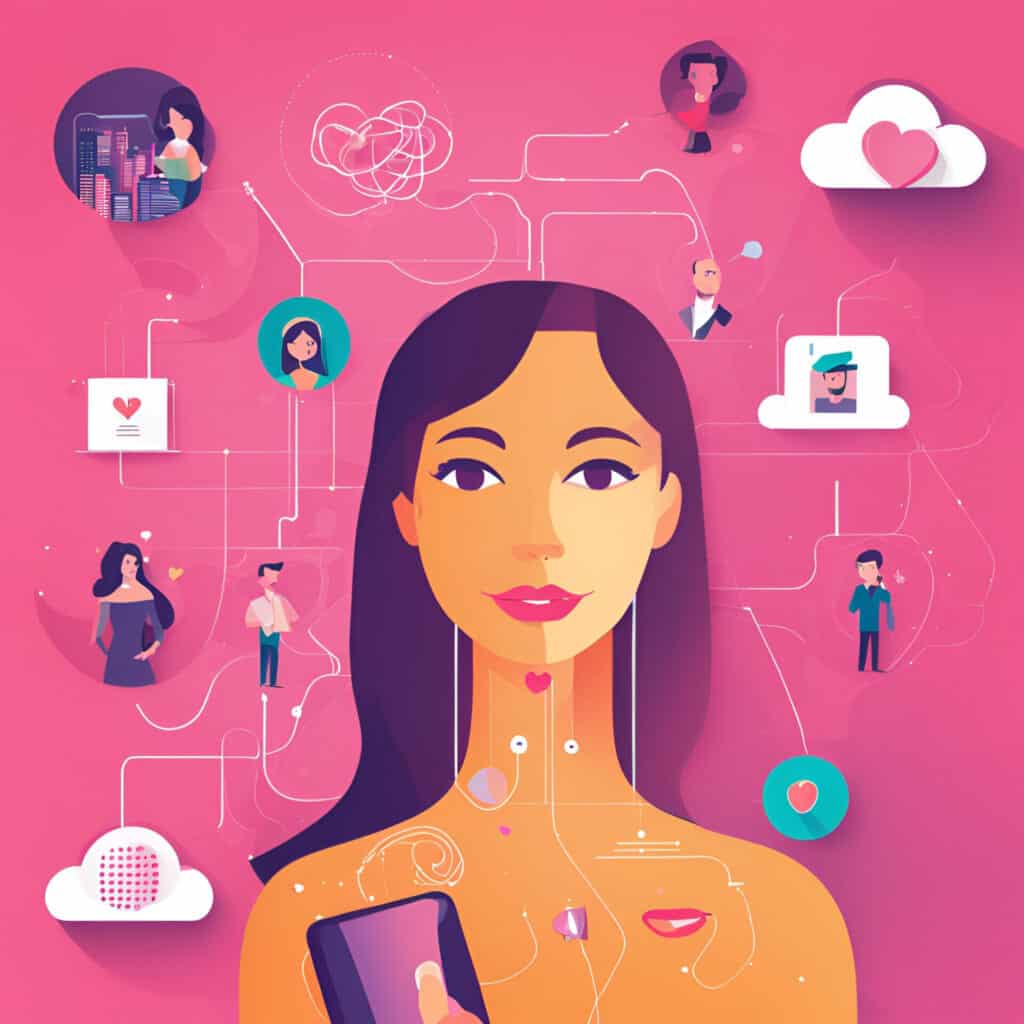In the fast-paced, technologically driven world of modern dating, Artificial Intelligence (AI) is emerging as a game-changer. Dating platforms, including major players like Hinge, Tinder, Bumble, and Replika, are harnessing the power of AI to combat ‘online dating exhaustion’ and redefine how users interact with each other. These platforms are integrating AI into their services to offer ‘tech-emotional’ support, reimagining the dating experience for users across generations, particularly Gen Z and beyond.
From profile creation till actual setting up of dates, this is how AI is transforming the dating industry and is literally acting as a digital wingman.
AI-generated profile:
Dating apps like Tinder and Bumble are leveraging AI to elevate the profile creation process. By analyzing user activity and preferences, these platforms offer tailored suggestions to optimize profiles for maximum impact. This includes recommendations for improving bio content, selecting more engaging photos, and even suggesting photo styles that have proven to attract more matches. This AI-driven guidance streamlines the profile creation process and empowers users to present their best selves, increasing their chances of finding meaningful connections.
Intelligent filters and preferences
AI is revolutionizing the filtering process on dating apps, empowering users to move beyond simple criteria like age, gender, and location. For example, Tinder leverages AI to fine-tune search results based on individual activity levels, lifestyles, and even nuanced preferences such as political leanings or humor. Additionally, AI analyzes user interactions to provide profile suggestions and feedback, boosting visibility and overall appeal. Hinge uses AI to offer specific recommendations for improving profile responses and photos, helping users craft more compelling profiles that resonate with potential matches.
AI-Guided Personality Insights
Some apps are now integrating AI to analyze users’ personalities and preferences, providing a deeper understanding of compatibility. For example, Tinder uses AI to identify shared interests and values, suggesting matches based on potential for long-term compatibility. This goes beyond surface-level interests, delving into deeper psychological factors, such as introversion vs. extroversion or communication styles. By considering these nuanced aspects of personality, AI algorithms can identify matches that share core values and traits, leading to more fulfilling and lasting connections.
AI-Driven Matchmaking Algorithms:

To provide ideal matches, dating apps analyze user data, including stated preferences, in-app behavior, and swiping patterns. This data allows them to suggest and refine potential matches based on compatibility. AI enhances this process by continuously learning from user actions, chats, behavior & changes being made to the user’s profile and recommending matches based on the types of profiles users engage with the most, significantly increasing matchmaking accuracy.
For example, Bumble employs a multi-faceted approach to identify the most suitable matches. Initially, it utilizes Feature Extraction techniques to gather data points such as activity patterns, location, and stated preferences. Subsequently, through Model Training, an algorithm leverages this extracted information to predict potential matches for the user. By continuously repeating these steps in real-time, the algorithm dynamically adapts and refines its recommendations to align with the user’s ongoing interactions and evolving preferences. AI further enhances this process by performing the initial filtering, presenting users with a curated selection of potential matches that are more likely to be compatible.
This reduces the prevalence of fake or mismatched profiles. It also presents opportunities for dating platforms to introduce premium subscription tiers that leverage AI-driven matchmaking.
Also Read: “This Driver Respect Women” Sticker – 3 Situations that make it a disgusting marketing ploy.
Conversation starters and Icebreakers:
AI-powered dating apps are breaking the ice for users by offering conversation assistance and smart suggestions. By analyzing profile content, including photos, responses and bios, AI can generate personalized conversation starters tailored to the potential match’s interests.
AI-powered dating apps are breaking the ice for users by offering conversation assistance and smart suggestions. By analyzing profile content, including photos, responses and bios, AI can generate personalized conversation starters tailored to the potential match’s interests.
For example, Tinder’s “Smart Messaging” suggests questions or prompts when a conversation stalls, encouraging further interaction.
Additionally, AI can analyze ongoing chats to identify potential conversation lulls and suggest relevant prompts to keep the interaction flowing smoothly. Furthermore, AI can predict the success of a match by analyzing behavioral patterns, giving users an insight into which matches are more likely to engage based on past interactions.
In- App Coaching and advice:
To foster positive and successful interactions, platforms like Hinge are integrating AI- powered coaching and advice features directly into their apps. These features provides users with tailored suggestions on how to initiate and maintain engaging conversations, as well as tips for enhancing their responses.
By analyzing user data and interactions, AI can offer personalized guidance, such as recommending icebreaker questions based on a potential match’s interests or suggesting improvements to profile prompts and photos. This real-time feedback and support empowers users to navigate the online dating landscape with greater confidence and skill, ultimately increasing their chances of forming meaningful connections.
AI-Driven Emotional Intelligence
Dating apps are increasingly incorporating AI to analyze the emotional tone of conversations. For example, sentiment analysis can be used to categorize messages as positive, negative, or neutral, allowing the app to prioritize and surface conversations that are more likely to be enjoyable and engaging. Some platforms are even exploring advanced AI algorithms capable of analyzing emotional cues in both text and images. For instance, facial recognition technology could be used to assess emotional states based on facial expressions, potentially enabling the app to match users based on emotional compatibility or shared moods.

Enhanced user safety and security
AI significantly enhances user safety and security on dating platforms. For instance, Bumble and Tinder utilize AI-powered photo verification to ensure profile authenticity. Users are prompted to submit selfies that align with their profile pictures, and AI algorithms analyze these images to detect inconsistencies. This process helps to minimize the presence of fake profiles and catfishers, fostering a more trustworthy environment.
Furthermore, AI continuously monitors user behavior, flagging suspicious activities like spamming, harassment, or the use of offensive language. By swiftly identifying and taking action against such behavior, AI helps maintain a safe and respectful online space for all users.
Smart Date Planning and Recommendations
Leveraging AI, dating apps like Bumble can now offer location-based suggestions for potential date venues and activities, even extending to virtual date ideas, all tailored to the couple’s shared interests. These recommendations can range from cozy local cafes to exciting virtual experiences, helping users seamlessly transition their online connection to the real world. Some apps even go a step further by suggesting local events and activities based on shared interests, facilitating a smooth and enjoyable shift from virtual interactions to engaging, real-life experiences.
Virtual Reality and Augmented Reality Integration
Dating apps are exploring innovative ways to enhance user experiences through virtual and augmented reality. For example, Tinder has experimented with “Swipe Night,” an interactive AR experience that allows users to make choices that impact their matches. Additionally, AI is being used to power voice and video-based matching features that enable users to assess compatibility through vocal tones and body language cues.
AI plays a crucial role in enabling these immersive experiences. Object recognition and segmentation algorithms allow AR apps to seamlessly blend virtual content with real-world environments. AI-powered motion tracking ensures that virtual objects accurately respond to user movements, creating a more realistic and interactive experience. Furthermore, natural language processing enables voice and gesture interactions, adding another layer of immersion and accessibility. By analyzing real-time data, including user actions, preferences, and even facial expressions, AI algorithms can personalize and optimize these virtual experiences, making them more engaging and relevant for users.
Conclusion
The dating landscape is undergoing a seismic shift, driven by the rapid advancements in AI. From enhancing user experiences and personalizing matches to prioritizing safety and fostering genuine connections, AI is redefining the way we seek companionship. As AI continues to evolve, we can anticipate even more innovative features and functionalities that will further transform the online dating experience, making it more efficient, enjoyable, and successful for users worldwide. While challenges and ethical considerations remain, the potential of AI to revolutionize the way we find love and connection is undeniable.

3 Comments
Insightful
This article provides an insightful look into how artificial intelligence reshapes modern dating.
Some truly nice and useful information on this website, likewise I think the style has superb features.